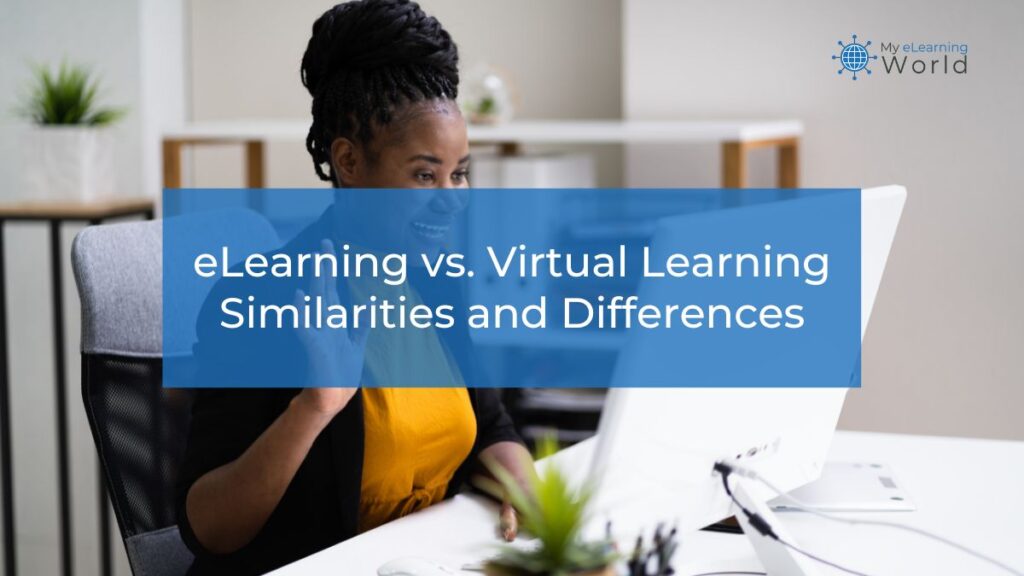Virtual learning and eLearning are terms that are used more and more often to describe the latest forms of education. Unfortunately, knowing the difference between the two is not always easy. I spoke with Columbia College of Missouri, a pioneer in distance learning, to gain more insight into the differences between virtual and eLearning. What I learned is that there is no consistent definition across all educational institutions. This can make distinguishing the two even more confusing.
In order to help my readers, I have put together this guide to help explain what is meant by eLearning vs virtual learning. For an excellent example of these learning styles, you can look at my list of instructional design training courses as well.
Quick Answer: What’s the Difference Between eLearning and Virtual Learning?
Virtual learning usually offers more interaction between students and instructors, while eLearning is more self-paced. eLearning is also primarily done through an LMS and doesn’t involve live video conferencing, whereas virtual learning can be real-time and often uses platforms like virtual conference systems.
What is Virtual Learning?
Virtual learning differs from traditional learning by providing instruction online rather than in-seat. It is carried out using a platform that is almost always internet-based. In many cases, virtual learning is taught in real-time with an instructor leading a class on a virtual conference platform. However, it can also be a self-paced course that includes aspects of student/teacher communication.
Forms and Platforms of Virtual Learning
The forms and platforms of this type of learning can vary depending on the educational institution. In most instances, I’ve found that video is the primary means to convey information to the student. This video may be pre-recorded or real-time. Virtual instruction usually uses a learning management system, or LMS.

Students have access to their instructor through email or chat. They usually have access to study groups and/or other classmates through the form of message boards, social media groups or chat rooms.
Textbooks and study guides are almost exclusively online. Students might be encouraged to purchase physical books, but this is becoming less common.
Assignments are delivered to the instructor through online portals. Instructors might have an email that is dedicated to receiving assignments, but it is more common for students to upload assignments to a drive that the instructor can then access.
Quizzes and tests are all computer based. Some learning institutions might require that students take tests in real-time using a timer in order to discourage cheating. Others use the honor system and allow the students to take tests around their own schedules.
Advantages and Disadvantages of Virtual Learning
Arguably, the greatest advantage of virtual learning is the ability to take classes from anywhere in the world. A full-time student can take courses that originate at another school. A parent who works 40 hours per week can still find time to take courses at night from the comfort of their own home without having to find a babysitter.

Another advantage of this method of learning is wide range of classes offered. Online education is not limited to colleges and universities. Individuals can earn personal fitness certification through online courses. They can take foreign language classes or learn how to knit. There is virtually no limit to the type of material that can be studied.
Flexibility is sometimes a benefit of virtual learning. Though there are some classes that require students to meet at a specific time, many allow students to learn around their own schedules.
The primary disadvantage to online learning is the lack of immediate access to an instructor. While virtual learning does give students the ability to reach out to the instructor, a live class offers immediate question and answer time. Likewise, some learners are more successful when they are in an in-seat environment versus learning at home.
Similar Terms
Terms are sometimes used interchangeably, which is understandably confusing. Following are some terms that are similar to virtual learning but have important differences.
Web-based Learning or Online Learning
These catch-all terms refer to any type of learning that takes place through the internet. Web-based or online learning could be virtual, blended, or eLearning. In all cases, this type of learning takes place through an internet browser or app.
Blended Learning
When a traditional classroom setting is combined with online education, this is called blended learning.

This may be a situation in which instruction takes place within a classroom where the lecture is also being broadcast online. Students have the option to attend class physically or to log in to the online portal.
Another method of blended learning involves certain aspects of a course taking place online while others are in-seat. This is common with classes that require lab work.
Distance Learning or Distance Education
Any learning that does not take place within a classroom and with an instructor present can be considered distance education.

Distance learning can take place online, but it is not necessary. When I first started paying attention to distance learning in the “old days,” distance learning took the form of television-based courses (called telecourses) or correspondence, which involved mailing physical materials.
Sounds crazy, huh? Well, these methods are now extremely rare.
eLearning
In its simplest definition, eLearning consists of courses delivered electronically. The actual details of eLearning are much more complex.
What is eLearning?
eLearning (sometimes written as E-Learning) uses electronic communication for instruction. The way this has been carried out has changed over the years, but today it is mostly done through an LMS.

Students access their classes from home or in a distance-based classroom setting. All courses are led by instructors but those instructors do not meet with students in person. Even the degree is received through online methods.
Unlike virtual learning, this type of learning rarely takes place in real-time. Most instruction is available around the student’s schedule. Instructors are reached through messaging platforms or email. In almost all cases there is no live video conferencing.
Types of eLearning

Here are the most frequent types of e-learning:
Web-based
This is the most common type. Students access course materials when they want from their computer, smartphone, etc. Communication with instructors, including all class assignments and tests, are carried out through the web-based platform.
Video Modules
Videos can be made in advance that offer instruction or lectures. These are usually delivered via the web or through apps. Students watch the videos and receive a certificate afterward. Some video modules require online quizzes to ensure students have absorbed the information.
Related: How to skip through online training videos
Mobile Learning
Apps are used to deliver information to students in a small, easily absorbed format. Mobile apps are usually performed on the student’s schedule.
Advantages and Disadvantages of eLearning

This type of virtual learning is one of the most cost-effective ways of learning. Many courses available on the web are low cost or even free. Students rarely have to buy supplemental materials. Because it is all web-based, students don’t have to take time off from work or find childcare as they might for other types of classes.
Flexibility is vital to many students. Web-based learning offers the utmost in flexibility. Students can learn at their own pace around a schedule that works for them.
The disadvantage of this type of learning is not the same for everyone. These learning modules may not have assessments or even oversight from instructors. Therefore, students only learn as much from the classes as they choose. While it may be ideal for many students, others might need more direct contact from an instructor.
eLearning vs Virtual Learning
The difference between eLearning and virtual learning is the amount of interaction involved. Virtual learning has more interaction between students and instructors while eLearning is more self-paced.

Choosing which one is better is up to the individual. For example, I personally prefer eLearning, as I excel at independent learning. But those who feel they need more interaction would benefit from virtual learning. It is the closest way to feel a classroom environment without actually stepping into a classroom.
Students who feel they are good independent learners can save money and time through eLearning. These types of modules are good for people who want to try web-based education without a strong commitment. They are also excellent choices for people who have already proven that they are able to learn without oversight or who are simply interested in enhancing skills they already have.
Conclusion
Education has significantly changed over the last 100 years. In one of my previous articles I talked about that, at one time, students could only learn by going to classes, sometimes far away from home, and paying the related fees. Over time, students have become more independent and more willing to seek education on their own. With the advent of the internet, students can be educated anywhere in a variety of different ways. When it comes to eLearning vs virtual learning, the differences are small but important.

